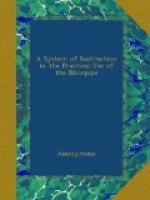In the pure state, the alkaline earths are caustic, cause red litmus paper to become blue, and are more or less soluble in water. Their sulphides are also soluble. The carbonates and phosphates of the alkaline earths are insoluble in water. By igniting the carbonates, their carbonic acid is expelled, and the alkaline earths are left in the caustic state. The alkaline earths are not volatile, and their organic salts are converted, by ignition, into carbonates.
(a.) Baryta. (BaO).—This alkaline earth does not occur free in nature, but combined with acids, particularly with carbonic and sulphuric acids. In the pure state, baryta is of a greyish-white color, presents an earthy appearance, and is easily powdered. When sparingly moistened with water, it slakes, becomes heated, and forms a dry, white powder. With still more water it forms a crystalline mass, the hydrate of baryta, which is completely soluble in hot water. Pure baryta is infusible; the hydrate fuses at a red heat, without the loss of its hydratic water; if caustic baryta is exposed for too great a length of time to the flame, it absorbs water, originated by the combustion, and becomes a hydrate, when it will melt. Salts of baryta, formed with most acids, are insoluble in water; for instance, the salts with sulphuric, carbonic, arsenic, phosphoric, and boracic acids. The salts of baryta, soluble in water, are decomposed by ignition, except the chloride.
Carbonate of baryta loses its carbonic acid at a red heat, becomes caustic, and colors red litmus paper blue.
By exposing baryta or its compounds upon a platinum wire, or a splinter of the substance held with the platinum tongs, to the point of the blue flame, a pale apple-green color is communicated to the external flame. This color appears at first very pale, but soon becomes more intense. This color is most visible if the substance is operated with in small quantities. The chloride of barium produces the deepest color. This color is less intense if the carbonate or sulphate is used. The presence of strontia, lime, or magnesia, does not suppress the reaction of the baryta, unless they greatly predominate.
When alcohol is poured over baryta or its salts, and inflamed, a feeble green color is communicated to the flame, but this color should not be considered a characteristic of the salt.
Baryta and its compounds give, when fused with carbonate of soda upon platinum foil, a clear bead. Fused with soda upon charcoal, it is absorbed. The sulphate fuses at first to a clear bead, which soon spreads, and is absorbed and converted while boiling into a hepatic mass. If this mass is taken out, placed upon a piece of polished silver and moistened with a little water, a black spot of sulphide of silver is left after washing off the mass with water.
Borax dissolves baryta and its compounds with a hissing noise, as well in the flame of oxidation as in that of reduction. There is formed a clear bead which, with a certain degree of saturation, is clear when cold, but appears milk-white when overcharged, and of an opal, enamel appearance, when heated intermittingly, or with a vacillating flame, that changes frequently from the oxidating to the reducing flame. Baryta and its compounds produce the same reactions with microcosmic salt.




